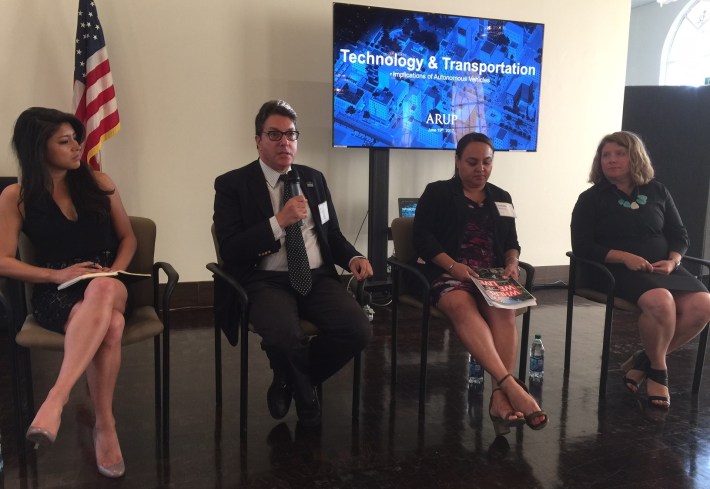Proponents of autonomous vehicles paint a pretty rosy picture of the future: dramatically safer streets, automated transit vehicles, no need for parking spaces, so just kick up your heels and watch Netflix while you commute.
That autonomous future also includes a number of potentially unhealthy scenarios: vehicles inaccessible to the elderly or the disabled, massive job losses, increases in miles traveled ("just circle the block while I run in, Hal"), and an unknown cost to the end user when ride-hail companies run out of the venture capital funding that they now burn through.
These and other scenarios were explored last night at The Future of Our Cities: Smart Technology and Its Impact on Urban Transportation, hosted by ARUP and the Westside Cities Council of Governments, at the city of Beverly Hills Municipal Gallery. Speakers included ARUP Principals Katherine Perez-Estolano and Will Baumgardner, Beverly Hills City Councilmember John Mirisch, LADOT General Manager Seleta Reynolds, AARP Associate State Director Stephanie Ramirez, and Cruise Automation Government Affairs Manager Nadia Marquez.

Various potential future implications were introduced in a presentation by Baumgardner, whose research showed the following range of changes that are predicted under autonomous vehicles:
- Safety: +40 percent to +90 percent - in reducing/eliminating crashes due to human error
- Capacity: 0 to +45 percent - with a minimum scenario being a basic capacity increase due to reduced crashes (likely offset due to induced travel)
- Miles Driven: +5 percent to +50 percent increase in Vehicle Miles Traveled (VMT)
- Green House Gas Emissions: -50 percent to +100 percent
Mirisch and Marquez were more optimistic about the autonomous future. Marquez touted the safety benefits, but also emphasizing the convenience and speed of not having to account for parking. Mirisch, long a proponent of Beverly Hills planned municipal autonomous shuttle system, asserted government's role in owning and operating autonomous vehicles as a city service, like police and fire.
Reynolds outlined that much of variability is down to the convergence (or lack thereof) of three current vehicle trends: autonomy, sharing, and electric power. If society can manage to tie these three together, then the most favorable outcomes emerge.
With shared electric autonomous vehicles - including not just cars, but shuttles and buses - people can, in Baumgardner's characterization, right-size their transportation choices, many choosing not to own a car. On the other hand, if any of these drop out, then current automotive problems likely worsen.
The transition itself, according to Reynolds, could be difficult too.
Reynolds stressed a need for government to play a key role in regulating autonomous vehicles. If the past is any indication, one-size-fits-all solutions are likely to favor wide open suburbs and rural areas, not cities. Reynolds emphasized that cities should "price and manage infrastructure" especially to incentivize and achieve desired outcomes. One of the only ways to keep VMT from soaring will be charge by the mile.
Reynolds also painted a flexible future for streets. With intelligent vehicles, it will be easier to close streets at certain times or on certain days. A commuter lane in the morning could become a park in the afternoon. Cities will need to manage their increasingly valuable curb space.
Reynolds shared the LADOT's 2016 report Urban Mobility in a Digital Age, a 172-page document outlining how Los Angeles can interface with emerging transportation technologies. The core of the report is to outline city strategies for use of autonomous vehicles, but the report also covers bike-share, car-share, parking technologies and much more. The report is the work of fellow Ashley Hand, advised by a bevy of forward-thinking transportation and planning professionals. There are lots of very worthwhile livability policies recommended: eliminating parking minimums, ending road widening, expanding Express Park performance pricing, expanding transportation demand management, and more. Curbed's in-depth coverage of the report called it "groundbreaking because it makes L.A. the first U.S. city to specifically address policies around self-driving cars."
Other thorny issues mulled over by the panel included jobs, privacy, development, equity/access, and more.
The autonomous future, predicted to be about a decade away way back in 1939, is still about a decade away, but getting nearer. Nonetheless, if Los Angeles wants the future to look more like the autonomous dream and less like the autonomous nightmare, regulations and incentives will need to be put in place soon.







